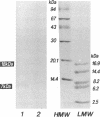Abstract
Cationic antibacterial proteins (CAP) were purified from rabbit granulocytes, and the effects of CAP on lipopolysaccharide (LPS)-induced tissue factor generation by murine peritoneal macrophages and human blood monocytes were studied. CAP were purified from rabbit peritoneal leukocytes by using as an assay the agglutination of erythrocytes coated with Re-LPS. Two proteins with CAP activity, CAP18 (18 kDa) and CAP7 (7 kDa), were isolated by acid extraction, ethanol precipitation, affinity chromatography, gel filtration, and reverse-phase high-pressure liquid chromatography. On the basis of protein sequencing, CAP7 was identified as the C-terminal fragment of CAP18, designated CAP18(106-142). Various forms of LPS (S-LPS, Re-LPS, and lipid A) activate murine macrophages and human blood monocytes to generate tissue factor (tissue thromboplastin). Incubation of LPS for 18 h with partially purified CAP (heparin-Sepharose fraction) inhibited the capacity of LPS to induce tissue factor; however, purified CAP18 inhibited about 75% of the activity of S-LPS after 1 h of incubation. CAP more effectively inhibited S-LPS than Re-LPS or lipid A. Synthetic CAP18(106-142) inhibited LPS-induced tissue factor generation by murine macrophages. CAP18(106-142) has greater LPS-binding and LPS-neutralizing activities than CAP18. We hypothesize that CAP18 and the derivative peptide, CAP18(106-142), bind to LPS and alter the capacity of LPS to initiate disseminated intravascular coagulation. In this regard, CAP may have therapeutic potential for sepsis and endotoxin shock.
Full text
PDF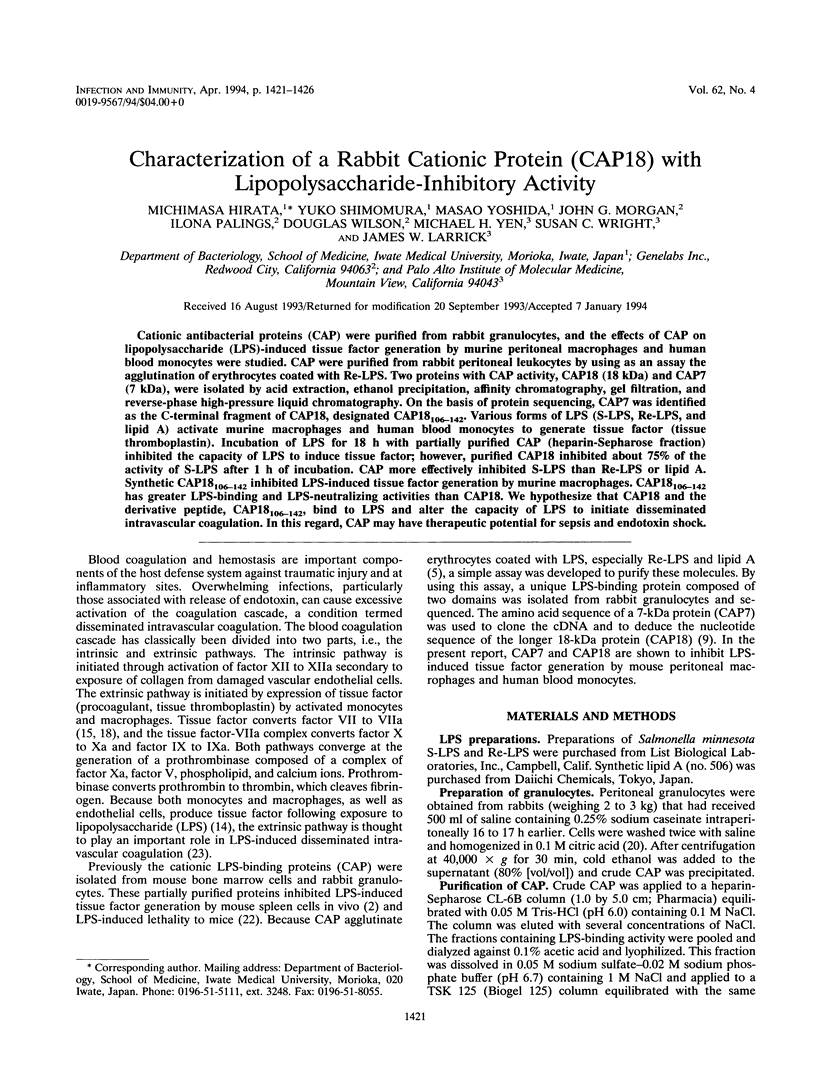
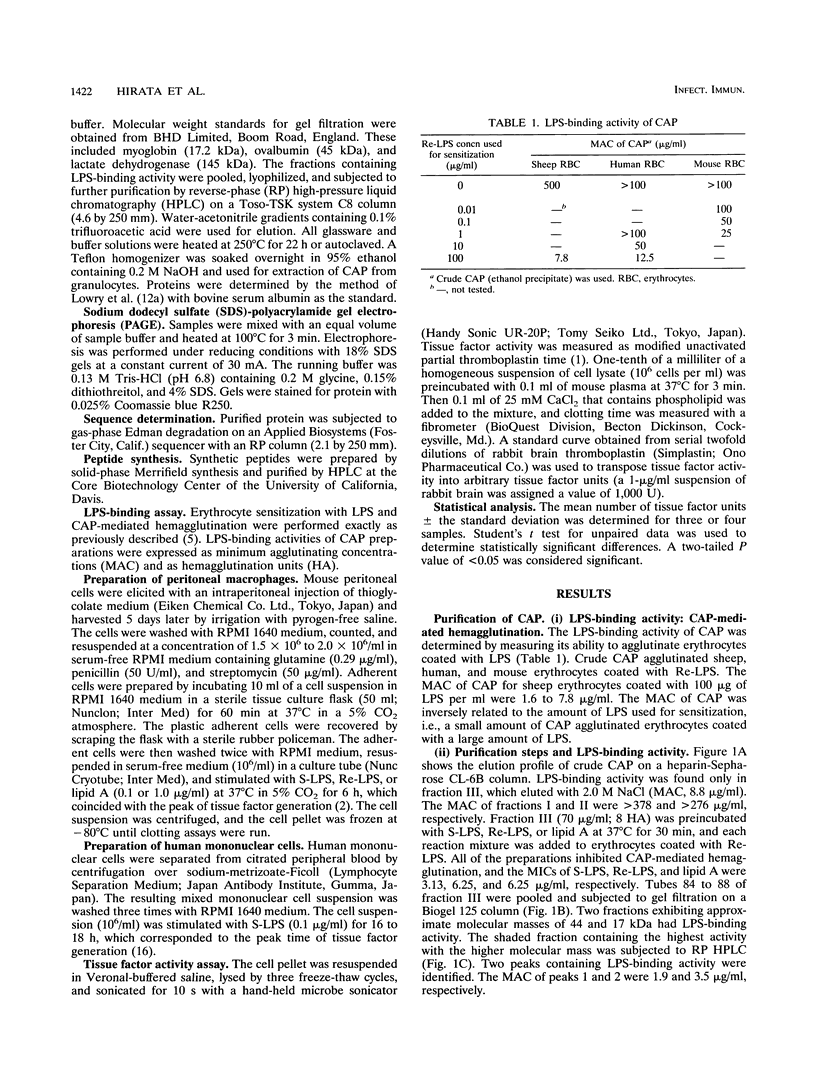
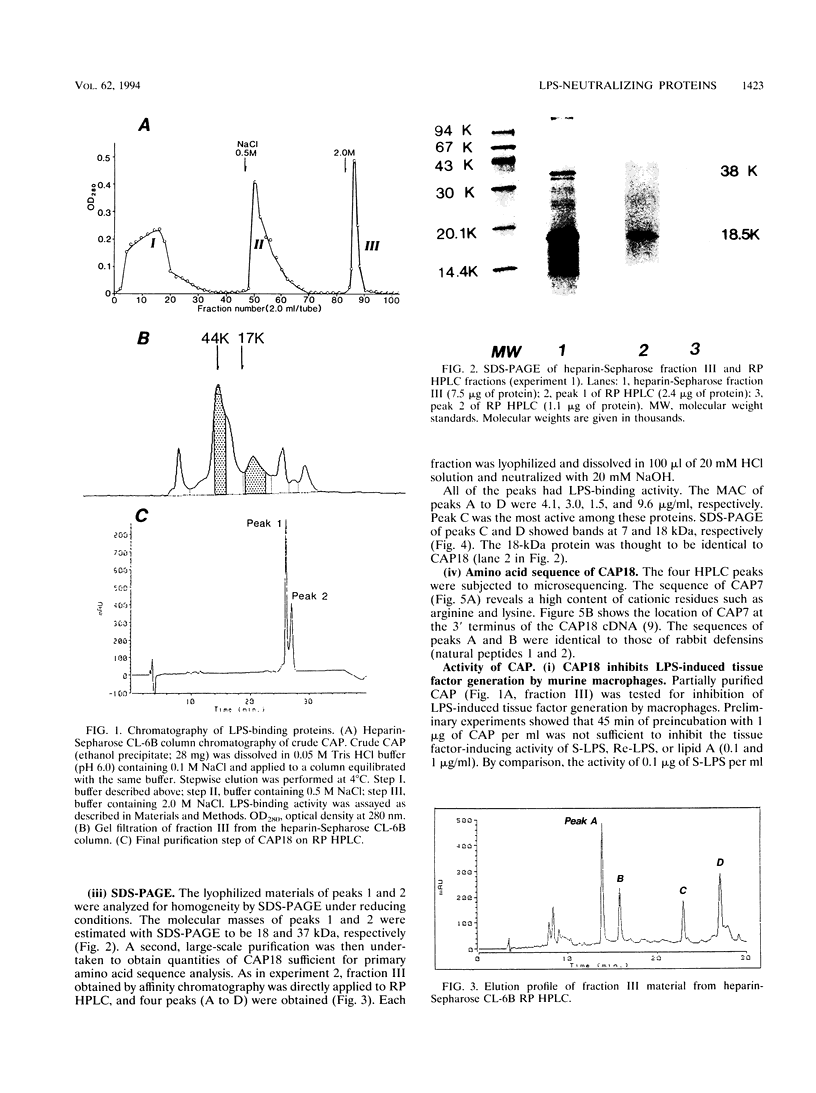
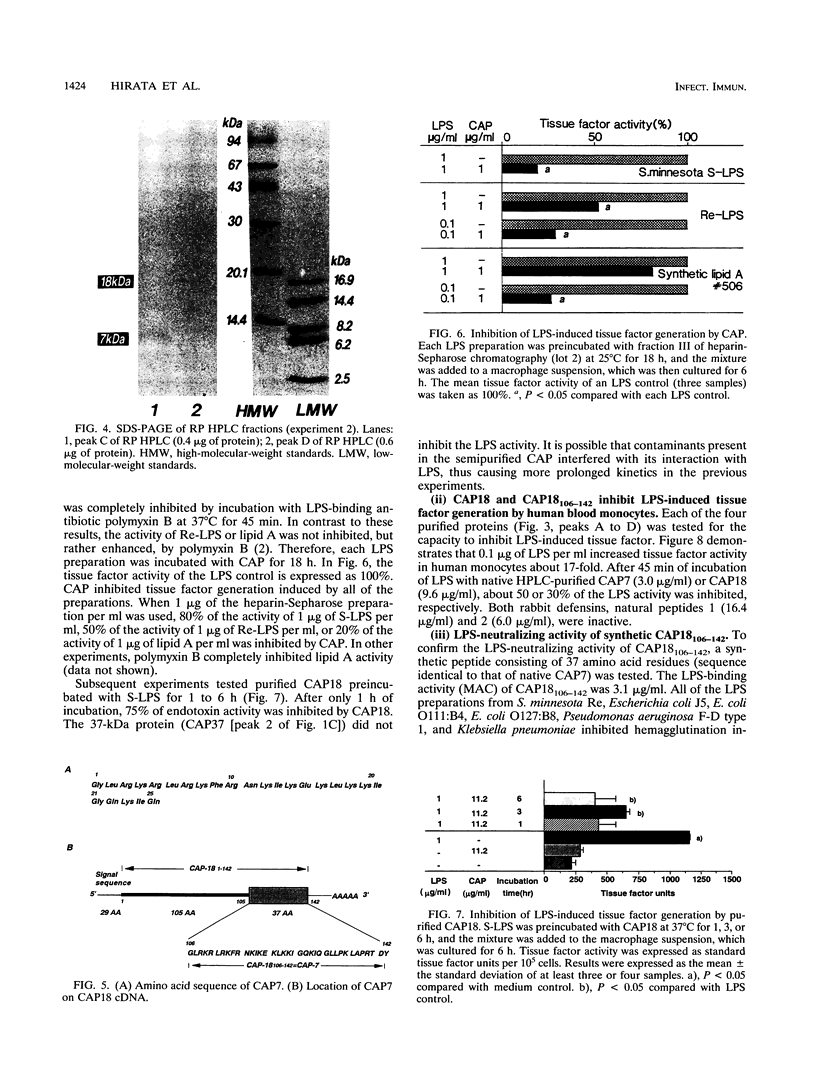
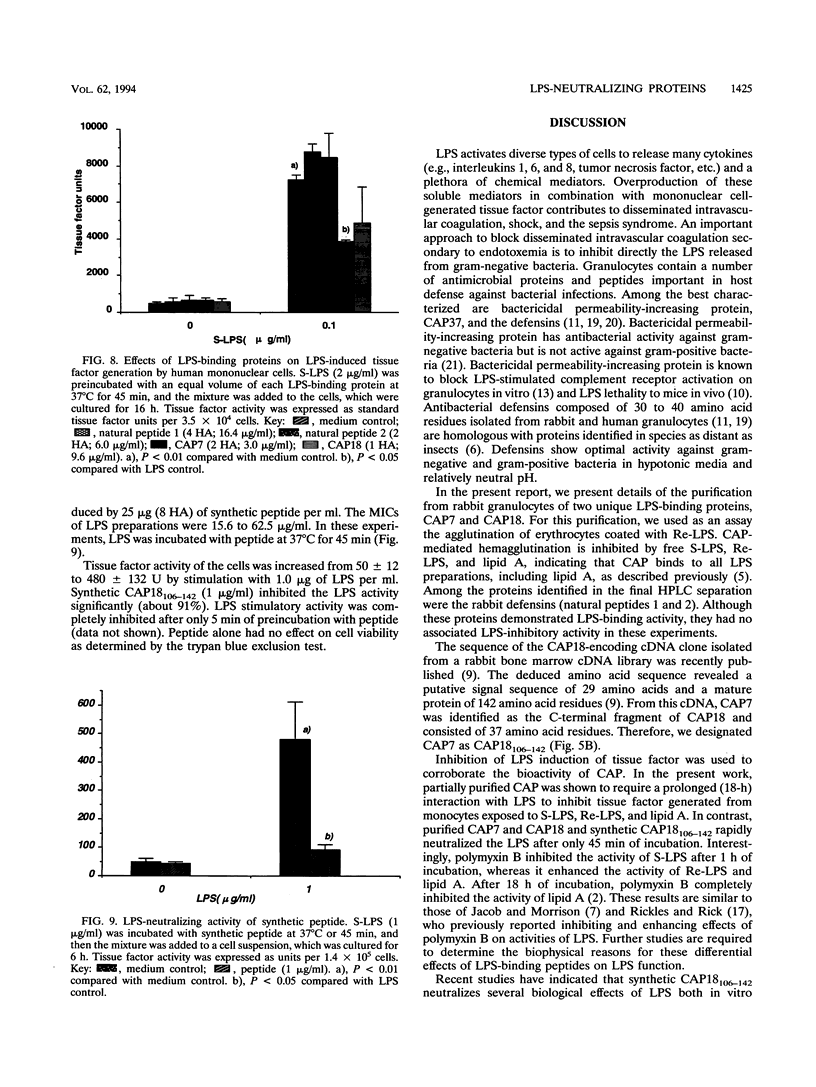
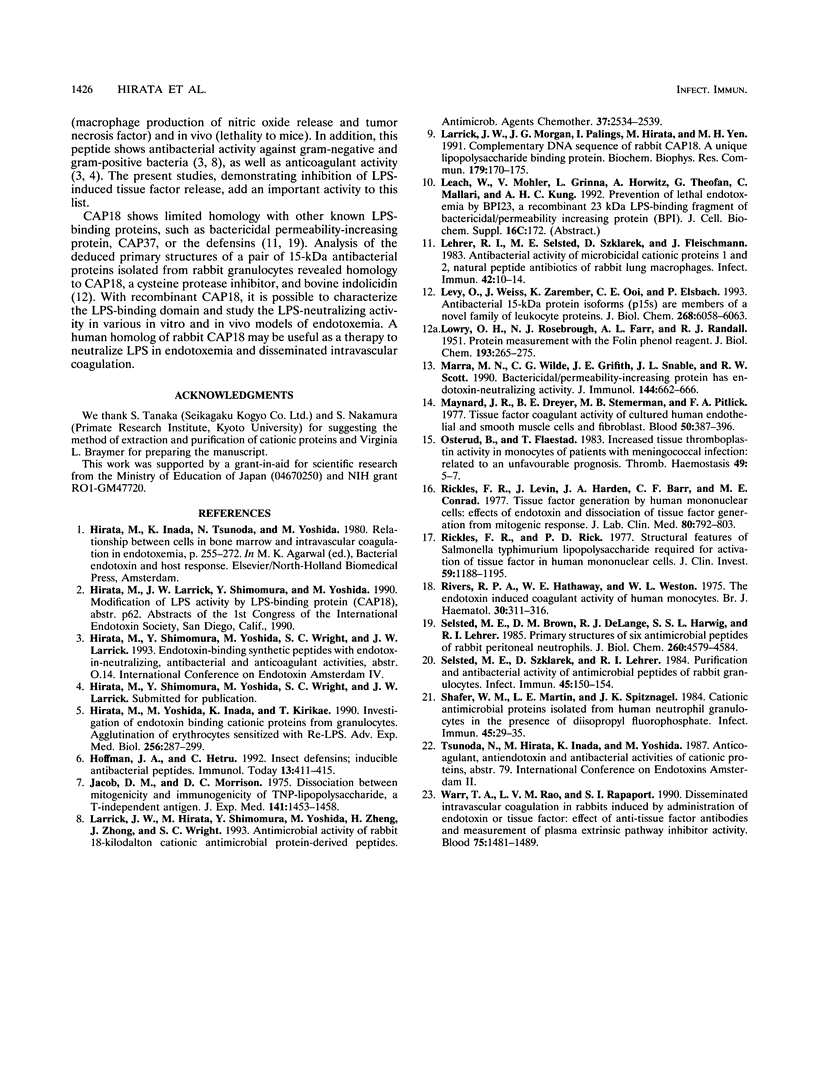
Images in this article
Selected References
These references are in PubMed. This may not be the complete list of references from this article.
- Hirata M., Yoshida M., Inada K., Kirikae T. Investigation of endotoxin binding cationic proteins from granulocytes; agglutination of erythrocytes sensitized with Re-LPS. Adv Exp Med Biol. 1990;256:287–299. doi: 10.1007/978-1-4757-5140-6_25. [DOI] [PubMed] [Google Scholar]
- Hoffmann J. A., Hetru C. Insect defensins: inducible antibacterial peptides. Immunol Today. 1992 Oct;13(10):411–415. doi: 10.1016/0167-5699(92)90092-L. [DOI] [PubMed] [Google Scholar]
- Jacobs M. D., Morrison D. C. Dissociation between mitogenicity and immunogenicity of TNP-lipopolysaccharide, a T-independent antigen. J Exp Med. 1975 Jun 1;141(6):1453–1458. doi: 10.1084/jem.141.6.1453. [DOI] [PMC free article] [PubMed] [Google Scholar]
- LOWRY O. H., ROSEBROUGH N. J., FARR A. L., RANDALL R. J. Protein measurement with the Folin phenol reagent. J Biol Chem. 1951 Nov;193(1):265–275. [PubMed] [Google Scholar]
- Larrick J. W., Hirata M., Shimomoura Y., Yoshida M., Zheng H., Zhong J., Wright S. C. Antimicrobial activity of rabbit CAP18-derived peptides. Antimicrob Agents Chemother. 1993 Dec;37(12):2534–2539. doi: 10.1128/aac.37.12.2534. [DOI] [PMC free article] [PubMed] [Google Scholar]
- Larrick J. W., Morgan J. G., Palings I., Hirata M., Yen M. H. Complementary DNA sequence of rabbit CAP18--a unique lipopolysaccharide binding protein. Biochem Biophys Res Commun. 1991 Aug 30;179(1):170–175. doi: 10.1016/0006-291x(91)91350-l. [DOI] [PubMed] [Google Scholar]
- Lehrer R. I., Selsted M. E., Szklarek D., Fleischmann J. Antibacterial activity of microbicidal cationic proteins 1 and 2, natural peptide antibiotics of rabbit lung macrophages. Infect Immun. 1983 Oct;42(1):10–14. doi: 10.1128/iai.42.1.10-14.1983. [DOI] [PMC free article] [PubMed] [Google Scholar]
- Levy O., Weiss J., Zarember K., Ooi C. E., Elsbach P. Antibacterial 15-kDa protein isoforms (p15s) are members of a novel family of leukocyte proteins. J Biol Chem. 1993 Mar 15;268(8):6058–6063. [PubMed] [Google Scholar]
- Marra M. N., Wilde C. G., Griffith J. E., Snable J. L., Scott R. W. Bactericidal/permeability-increasing protein has endotoxin-neutralizing activity. J Immunol. 1990 Jan 15;144(2):662–666. [PubMed] [Google Scholar]
- Maynard J. R., Dreyer B. E., Stemerman M. B., Pitlick F. A. Tissue-factor coagulant activity of cultured human endothelial and smooth muscle cells and fibroblasts. Blood. 1977 Sep;50(3):387–396. [PubMed] [Google Scholar]
- Osterud B., Flaegstad T. Increased tissue thromboplastin activity in monocytes of patients with meningococcal infection: related to an unfavourable prognosis. Thromb Haemost. 1983 Feb 28;49(1):5–7. [PubMed] [Google Scholar]
- Rickles F. R., Levin J., Hardin J. A., Barr C. F., Conrad M. E., Jr Tissue factor generation by human mononuclear cells: effects of endotoxin and dissociation of tissue factor generation from mitogenic response. J Lab Clin Med. 1977 Apr;89(4):792–803. [PubMed] [Google Scholar]
- Rickles F. R., Rick P. D. Structural features of Salmonella typhimurium lipopolysaccharide required for activation of tissue factor in human mononuclear cells. J Clin Invest. 1977 Jun;59(6):1188–1195. doi: 10.1172/JCI108743. [DOI] [PMC free article] [PubMed] [Google Scholar]
- Rivers R. P., Hathaway W. E., Weston W. L. The endotoxin-induced coagulant activity of human monocytes. Br J Haematol. 1975 Jul;30(3):311–316. doi: 10.1111/j.1365-2141.1975.tb00547.x. [DOI] [PubMed] [Google Scholar]
- Selsted M. E., Brown D. M., DeLange R. J., Harwig S. S., Lehrer R. I. Primary structures of six antimicrobial peptides of rabbit peritoneal neutrophils. J Biol Chem. 1985 Apr 25;260(8):4579–4584. [PubMed] [Google Scholar]
- Selsted M. E., Szklarek D., Lehrer R. I. Purification and antibacterial activity of antimicrobial peptides of rabbit granulocytes. Infect Immun. 1984 Jul;45(1):150–154. doi: 10.1128/iai.45.1.150-154.1984. [DOI] [PMC free article] [PubMed] [Google Scholar]
- Shafer W. M., Martin L. E., Spitznagel J. K. Cationic antimicrobial proteins isolated from human neutrophil granulocytes in the presence of diisopropyl fluorophosphate. Infect Immun. 1984 Jul;45(1):29–35. doi: 10.1128/iai.45.1.29-35.1984. [DOI] [PMC free article] [PubMed] [Google Scholar]
- Warr T. A., Rao L. V., Rapaport S. I. Disseminated intravascular coagulation in rabbits induced by administration of endotoxin or tissue factor: effect of anti-tissue factor antibodies and measurement of plasma extrinsic pathway inhibitor activity. Blood. 1990 Apr 1;75(7):1481–1489. [PubMed] [Google Scholar]




